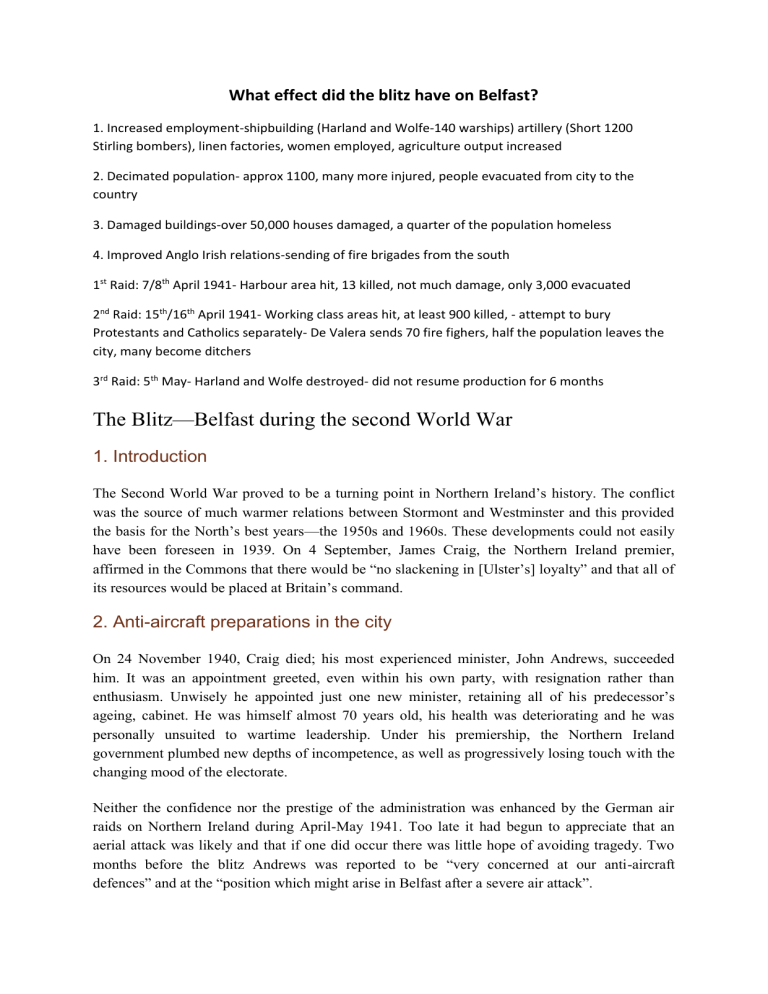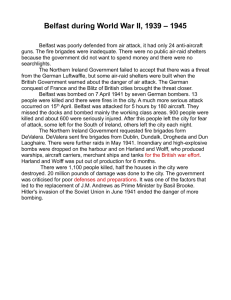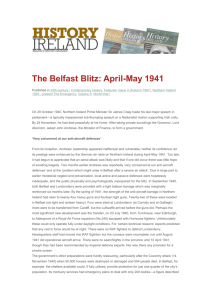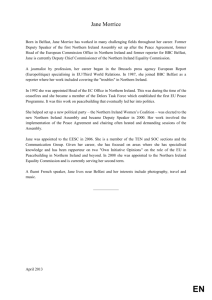What effect did the blitz have on Belfast?

What effect did the blitz have on Belfast?
1. Increased employment-shipbuilding (Harland and Wolfe-140 warships) artillery (Short 1200
Stirling bombers), linen factories, women employed, agriculture output increased
2. Decimated population- approx 1100, many more injured, people evacuated from city to the country
3. Damaged buildings-over 50,000 houses damaged, a quarter of the population homeless
4. Improved Anglo Irish relations-sending of fire brigades from the south
1 st Raid: 7/8 th April 1941- Harbour area hit, 13 killed, not much damage, only 3,000 evacuated
2 nd Raid: 15 th /16 th April 1941- Working class areas hit, at least 900 killed, - attempt to bury
Protestants and Catholics separately- De Valera sends 70 fire fighers, half the population leaves the city, many become ditchers
3 rd Raid: 5 th May- Harland and Wolfe destroyed- did not resume production for 6 months
The Blitz—Belfast during the second World War
1. Introduction
The Second World War proved to be a turning point in Northern Ireland’s history. The conflict was the source of much warmer relations between Stormont and Westminster and this provided the basis for the North’s best years—the 1950s and 1960s. These developments could not easily have been foreseen in 1939. On 4 September, James Craig, the Northern Ireland premier, affirmed in the Commons that there would be “no slackening in [Ulster’s] loyalty” and that all of its resources would be placed at Britain’s command.
2. Anti-aircraft preparations in the city
On 24 November 1940, Craig died; his most experienced minister, John Andrews, succeeded him. It was an appointment greeted, even within his own party, with resignation rather than enthusiasm. Unwisely he appointed just one new minister, retaining all of his predecessor’s ageing, cabinet. He was himself almost 70 years old, his health was deteriorating and he was personally unsuited to wartime leadership. Under his premiership, the Northern Ireland government plumbed new depths of incompetence, as well as progressively losing touch with the changing mood of the electorate.
Neither the confidence nor the prestige of the administration was enhanced by the German air raids on Northern Ireland during April-May 1941. Too late it had begun to appreciate that an aerial attack was likely and that if one did occur there was little hope of avoiding tragedy. Two months before the blitz Andrews was reported to be “very concerned at our anti-aircraft defences” and at the “position which might arise in Belfast after a severe air attack”.
Due in large part to earlier ministerial neglect and prevarication, local defences were hopelessly inadequate, and the public were physically and psychologically unprepared for the blitz. In
September 1940, both Belfast and Londonderry had been provided with a light balloon barrage, which was marginally reinforced six months later. By the spring of 1941, the strength of the antiaircraft barrage in Northern Ireland had risen to 24 heavy guns and 14 light guns. Twenty-two of these were located in Belfast (6 light and 16 heavy). Four were sited at Londonderry; more were to be transferred from Cardiff, but the Luftwaffe arrived before the guns did. Perhaps the most significant new development had been the transfer, on 20 July 1940, to Aldergrove from
Turnhouse, near Edinburgh, of a RAF squadron (No. 245) equipped with Hurricane fighters.
Unfortunately these could only operate fully under daylight conditions; experts predicted that any enemy raid in force would be at night. There were no RAF fighters to defend Londonderrry.
Headquarters staff had moved into RAF Eglinton but the runways were incomplete; not until
August 1941 did operational aircraft arrive. There were barrage balloons but no searchlights in the province until 10 April 1941, even though they had been recommended by British defence experts. Nor was there any provision for a smoke screen to conceal Belfast’s vulnerable and easily identified dock area.
3. Government measures to protect civilians
The government’s other preparations were hardly reassuring, particularly after the Coventry attack (14 November 1940) when 50,000 houses were destroyed or damaged, and 554 people died. Its schemes to evacuate women and children from Belfast were described by one official as a “fiasco”; a mere 4,000 had left by April 1941. The shelters available in the city could, if fully utilized, provide protection for just one quarter of its population. Its mortuary services had emergency plans to deal with only 200 bodies—a civil servant at the time suggested that the figure was “hardly enough”. Finally, provision had been made for the care of a mere 10.000 people who might be made homeless as a consequence of any future enemy action.
In mid 1940, John MacDermott had been appointed Minister of Public Security, with responsibility for making preparations for an air raid; probably from his first day in office he was convinced that the region’s immunity hitherto could not last. He was appalled to discover that, up to the date of his appointment, the Home Affairs Ministry was returning fire-fighting equipment to Britain on the assumption that it would not be needed in the six counties. Numerous factors accounted for this attitude—the conviction that it was unlikely enemy bombers would risk twice crossing Britain, where there were more significant targets, in order to attack Belfast; the assumption that Eire’s neutrality would likely deter enemy attack; complacency bred by the fact that the province had escaped attack for so long (by March 1941, 28,000 civilians had already died as a result of German air-raids in Britain); lethargy and a lack of war urgency on the part of local ministers, their belief that defence was a Westminster rather than a local responsibility, their lack of funds, and their increasing difficulty as the blitz intensified in acquiring supplies of defence materiel from Britain.
4. Increased anxiety in the city
Too late most ministers came to acquire a keener sense of reality and proportion. Several factors heightened their awareness of Northern Ireland’s vulnerability. The fall of France increased fears of a German invasion of Ireland, and also immediately accentuated the strategic significance of
Britain’s northwest ports. From late summer, those in Great Britain were the objective of a major
Luftwaffe offensive—Glasgow, Liverpool, etc. The likelihood that this might be extended to
Northern Ireland was increased in 1941, when more munitions contracts began to be awarded to local firms as mainland industry approached maximum output. Moreover, from September 1940 onwards, enemy reconnaissance aircraft were reported over the province with increasing frequency (Belfast’s first red alert was on 1 October 1940, and they averaged almost one per week over the next six months). It has since become clear that the German leadership was preparing for an assault, focussing particularly on the city’s expanding munitions producers, its increasingly active docks and its vital public utilities. Comprehensive files were being produced containing aerial photographs, maps and detailed instructions for Luftwaffe crews indicating the position of potential targets and also their defences and military significance.
But the time was too short. On 29 March 1941, MacDermott wrote to the Prime Minister highlighting in the “strongest possible terms” the utter inadequacy of local defences—the lack of night-fighters, the shortages of anti-aircraft guns and the non-existence of searchlights. He concluded that the position was “not satisfactory” and that it was “doubtful whether Belfast was as well defended as any comparable city or port in any other part of the United Kingdom”.
5. The first raid
On the night of 7-8 April, Belfast experienced a light raid, involving probably 8 aircraft (their navigation lights still on!), which over a three and a half hour period concentrated their attack mainly on the dock area, causing 13 deaths. It failed to shake public complacency.
The city’s first major attack came one week later, on Easter Tuesday night, 15-16 April. An estimated 180 aircraft participated in an assault lasting for five and a half hours (11:30pm–4:55 am). Bombs fell on average at a rate of two per minute. There was virtually no resistance from the ground; due to blast damage to the city’s telephone exchange the anti-aircraft guns fell silent from 1:45am. 35,000 houses were damaged.
The final death toll was at least 900, with 600 seriously injured. It was so high because of the inadequacy of the city’s defences, the dearth and under-use of shelters, the small numbers who had been evacuated, and the fact that so many bombs had fallen on densely populated, working class areas. A Corporation medical official had earlier described some of the houses in these as
“mere hovels”; in some districts each dwelling was occupied by up to thirty people.
The city’s inadequate mortuary services were overwhelmed and as a result public baths (on the
Falls Road and Peter’s Hill) and a large fruit market (St. George’s) had to be improvised to cope with the dead. On 21 April, 163 unclaimed and unidentified bodies were taken from St. George’s
Market and given a public funeral.
6. The exodus begins
Its sentiments if not its eloquence are discernable in Andrews’ subsequent press statements. In fact, fear and panic had already reached epidemic proportions, especially in Belfast; its most obvious symptom was a “crash evacuation”, which was unprecedented in its scale and entirely unforeseen by the government. Even during the raid, people had begun to flee from the city—by car, on bicycles and on foot.
The latter were colloquially known as “ditchers”; during the hours of darkness they went “up the road” to take cover in hills, parks and fields, lying under hedges, and in dugouts and barns.
By late April, it was officially estimated that 100,000 people had fled from the city.
7 . The ‘fire raid’, third raid, 4-5 May 1941
Belfast experienced a further devastating bombardment on the night of 4-5 May—popularly referred to as the “fire raid”. During the course of 3 hours, roughly 100,000 incendiary bombs were dropped, followed by high explosives, from an estimated 200 aircraft, mainly on the central, northern and eastern portions of the city. Unlike Easter Tuesday when 50 bombers had had to divert due to deteriorating weather, conditions for bombing were described as being perfect.
Their best efforts were thwarted by an acute shortage of hose and appliances, blast damage to water pipes, and falling water levels as the tide turned. Eyewitnesses later claimed that, during the attack, the explosions were audible in Bangor and Lisburn and that, by dawn, the inferno they had caused was visible from the Glenshane Pass, 50 miles away. Over 200 buildings were ablaze by the time of the “all clear” at 4:25am (their still smouldering shells may have attracted 3 bombers who attacked the city shortly after midnight on the following night, killing 14 people). The number of fatalities reached almost 200, and once more the unidentified bodies were brought to
St George’s Market. The death toll was lower than on Easter Tuesday, because the attack had taken place on a Sunday night, had focussed mainly on the docks and city centre, and had featured a high proportion of incendiary devices. In addition, the shelters available in Belfast had been more fully occupied, and a large proportion of its citizens had already fled into the immediate countryside and beyond.
During the “fire raid”, Belfast’s key strategic industries sustained very heavy damage. No shipyard in Great Britain suffered greater physical destruction during a single attack than did
Harland & Wolff on this occasion.
The Belfast Telegraph reported the damage was so extensive that citizens, who had lived in it all their lives, lost their way in the city centre next day. As in mid-April, help in fighting fires and in
rescue work was provided by the troops based locally, and more was requested from all over
Northern Ireland, from Britain and from Eire. By sending firemen and appliances to Belfast, the south compromised its policy of neutrality and risked becoming a target itself. When war had broken out, Ribbentrop had menacingly informed de Valera that Germany would refrain from hostile action if Ireland maintained an unimpeachable policy of neutrality towards her.
For the first and only time in the entire war, Belfast made headline news in the German media after the 4-5 May raid. In graphic and detailed accounts, the claim was enthusiastically repeated that its industry had been devastated beyond recovery—its shipyard “completely destroyed”, its aircraft factory “severely affected”. These reports would have been widely accepted within the city itself. Morale all but collapsed; there was a widespread fear that the Luftwaffe was intent on pulverising the city
A Ministry of Home Affairs report estimated that by the end of that month as many as 220,000 persons had at least temporarily evacuated from the capital. They scattered throughout Ulster.
They arrived in Fermanagh having “nothing with them only night shirts”; 10,000 crossed the border. Superimposed on the massive British military presence in the province, available accommodation was stretched beyond its limits. Dawson Bates, the Minister of Home Affairs, had to inform the cabinet of the rack-renting of barns, and in some areas of up to 30 people crowded together in small houses.
8. The practice of ‘ditching’
Thousands of those remaining in the city “ditched”; during the hours of darkness they streamed
(“trekked”) along the main arterial roads to the suburbs, to shelter in parks, in ditches and hedgerows, until first light when they felt it safe to return. The scale of continuing public fear was highlighted when, after an air-raid alert on 23 July 1941, at 2:00am an estimated 30,000 fled from the city in motor vehicles, bicycles and on foot. An eyewitness likened it to “the crowds at a football match”. No aircraft appeared and no bombs fell. It was not until August 1941 that most of those who had evacuated, returned. They had quickly become bored with country life and irritated by the increased distances they had to travel to work. Moreover, they were encouraged to come back by the fact that Luftwaffe attacks on British cities had ceased from mid May, and the belief that, after Hitler had launched Operation Barbarossa against Russia (26 June 1941),
Germany’s bombers had transferred to the Eastern Front.
Meanwhile, police reports indicate that “ditching” had also become a feature of contemporary life in many of the province’s larger county towns. The habit was spread by evacuees from Belfast. In addition, it was because on Easter Tuesday night (15-16 April) a number of bombing incidents had occurred at various places, scattered along the Luftwaffe’s flight path. In the most serious of these the same features which had characterised the experience of the northern capital were paralleled though on an infinitely smaller scale—most of the bombs fell on residential property, the public was unprotected and unprepared, the defences were inadequate, blackout measures defective and the few shelters available under-utilised. In Londonderry, fifteen people were killed when ex-servicemen’s homes were struck in Messines Park. Ten guards died in Newtownards
when explosives fell on the town’s airport, and five civilians when private housing was struck in
Bangor, a quiet seaside town without any obvious strategic targets.
9. Conclusion
In the course of the four Luftwaffe attacks on Belfast, lasting ten hours in total, 1,100 people died, over 56,000 houses were damaged (53% of its entire housing stock), roughly 100,000 made temporarily homeless and £20 million damage was caused to property at wartime values. It came twelfth in the “league table” of urban areas attacked in the United Kingdom, as measured by weight of bombs dropped. Arguably, the air raids had a graver impact on the morale of the city’s citizens than on its industrial production or the activity of its docks. By 1941, Belfast had undoubtedly become a legitimate target for the Luftwaffe. The city was an increasingly significant base for naval vessels engaged in the Battle of the Atlantic, its port was used for the import of war materiel especially from the US and, after a slow beginning, war production in its industries steadily accelerated, having only been temporarily disrupted by the air raids.
Unemployment throughout the north actually fell by 30,000, between January-June 1941, owing to local firms attracting more British war contracts, to military enlistment, and the increasing numbers employed building shelters, and servicing members of the expanding armed forces based in the province—British and later American. Between 1940-44, Belfast’s shipyards produced 140 warships, 123 merchant vessels (10% on UK output), 500 tanks, 13 million aircraft parts and numerous ordinance pieces. Its aircraft factory made 1,200 Stirling bombers and 125 Sunderland flying boats and repaired 3,000 aircraft. Collectively munitions producers in the city produced 75 million incendiary bullets, 50,000 bayonets and various fittings, including components for the
Mulberry floating docks used during the Normandy invasion. One-third of the ropes required by the War Office (a quarter of a million tons) were made at Belfast rope-works; in addition, it manufactured 50,000 camouflage and cargo nets. Belfast’s textile and clothing industry contributed significantly to the province-wide output of 2 million flax fabric parachutes and 200 million yards of cloth for the forces; during the war, 90% of British servicemen’s shirts were produced in Northern Ireland.
In political terms, the blitz exacerbated further the government’s problems, confirmed its directionless, hesitant posture and lessened still further its residual popularity. During and after the raids, MacDermott was the butt of very bitter verbal attacks from backbenchers at Stormont.
In an attempt to mollify them, he addressed a Unionist Party meeting on civil defence and the cabinet reluctantly agreed to a parliamentary demand for a secret session. But his main concern was the impact of the raids on the attitude of the general public. In late May, he even raised with
Spender the possibility that public anger over the lack of local preparation for Luftwaffe attack, and the inadequacy of Northern Ireland’s defences might result in an assault by irate mobs on the parliament buildings at Stormont. It did not materialise. Nonetheless, in the context of the deepening and unprecedented unpopularity of his government—in the province, in parliament and within his own party—Andrews was eventually compelled to resign as prime minister in
April 1943.








